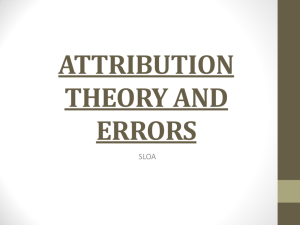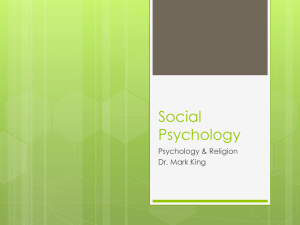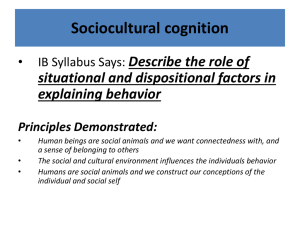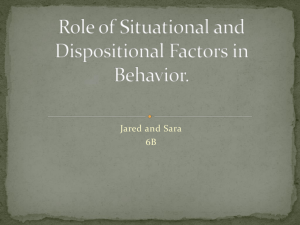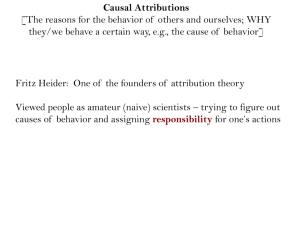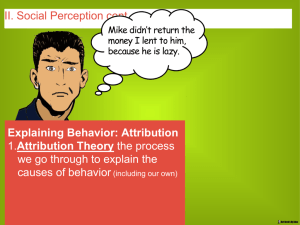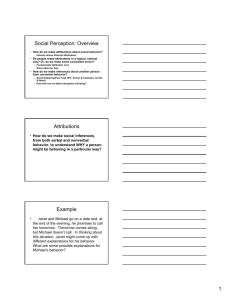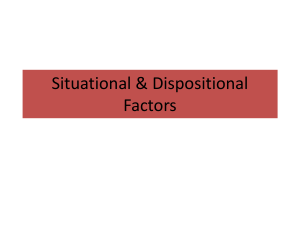Attribution and medi..
advertisement
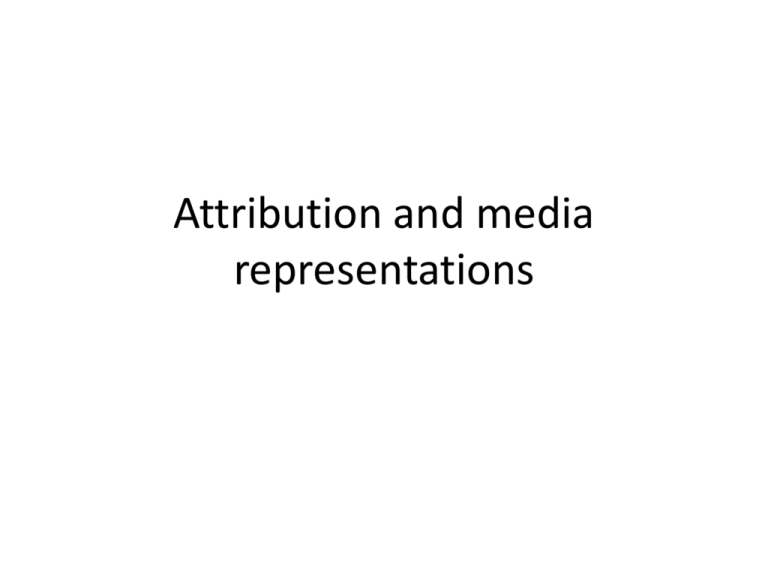
Attribution and media representations Outline of attribution theory • Human beings want to understand the world – Evolutionary advantages • Events and human behavior call for understanding – Want to be able to predict future behavior • Explanations are drawn from LTM for observed behaviors – Schema developed over time Attribution • Once explanations are developed they guide future explanations of similar behavior – Stimulus generalization • People will be judged according to the attributed causes of their behaviors • Future interactions with people whose behavior was attributed to some cause will be guided by those attributions Attributions • Those interactions will influence the relationship between the individuals • Those interactions will affect the selfperception of the interactants • Future behavior will be influenced by those self-perceptions, leading to new attributions and behaviors Heider: Attribution is characterized by: • Mental abstraction • Uncertainty reduction • Normativeness – Subsequent research called normativeness into question Influences over interpretation • “The information contained in a behavioral episode is often ambiguous; that is, it is associated with multiple categories. For example, a silent response may be interpreted as empathic, submissive, or hostile.” • Context • Prior knowledge of actor • Heider (1958) argued that a number of influences on observers determine their attribution of causes of behavior as either dispositional or environmentally driven – Indication of intent – Effort – Implication of personality trait • Default dispositional – Equifinality • Locus of control (whose fault) • Stability (is it ongoing) • Controllability (Can I change it?) Cues for attribution • Consensus – Everybody’s doing it • Distinctiveness – He’s the only one • Consistency – Cross-situational • Violations of social norms • Lack of situational cues Free will • Edward Jones and Keith Davis (1965) stressed that attributions of intentionality depend on the impression that the actor freely chose what to do. There had to be alternative options as well as a lack of situational pressures, such as coercion by others. • A chosen option is most informative if its alternatives differ in their consequences, and if the person was able to foresee these consequences. Biases • Observer’s self-esteem and social identity • Observer’s attentional focus and perspective • Observed behavior’s implications with regard to competence and morality – Immoral behavior requires immorality and success requires competence but moral behavior does not require morality and failure does not deny competence Audience factors • Some audience members are more likely to make dispositional attributions while others are more likely to make situational attributions Age of audience member • Young children do not perceive enduring dispositional factors • Older children (8-11 years) demonstrate opposite tendency • Teens weigh both factors Culture • Americans emphasize dispositional factors • Eastern cultures emphasize situational explanations • Difference increases with age--socialization Process • Identification – Choice of categorical definition of person, action • Attributional processing – Evaluate competing hypotheses of • Momentary state (intention, feeling, goal) • Enduring disposition (aggressiveness) • Situational forces (lack of choice, compulsion) Group membership • Application of group knowledge to individual – “Stereotyping” Observer’s processing goals • Research shows that asking observers to focus on personality leads to increase in dispositional attribution • Focusing on situation leads to an increase in situational attribution Processing capacity • Less time, capacity, distraction likely to increase default attributions – In U.S., that means dispositional Self-attributions • We don’t have the privileged insight into our own behaviors we think we do – We witness our own behaviors and then attributed causes to them – Usually we interpret them in ways biased in our favor • Good intentions • Environmental influences – Those with low self-esteem may attribute selfdeprecating causes • Attributions we developed in the past may affect our current self-attributions • Some of those attributions may come from our experience attributing causes to behaviors depicted in media • We tend to attribute “dispositional” causes to characters on television, etc. – We don’t take environmental constraints upon behavior into much account • Other cultures may be more likely to do so • More processing effort tends to increase our sensitivity to environmental influences – Affects the workings of dispositional theory Self-serving bias • When good things happen to me, I deserve it (I worked hard or I am a special person). • When good things happen to you, you don’t deserve it (the teacher likes you or you just got lucky). • When bad things happen to me, it’s not my fault (the teacher doesn’t like me or he started it). • When bad things happen to you, it’s your fault (you should work harder or you should be more careful). Inclusion in disposition theory Observed behavior Attribution Character evaluation Other relations to entertainment • Sometimes a good deal of the enjoyment of a narrative is tied to the process of attribution— figuring out why someone did something – Tying motive to action – Explaining circumstances that led to actions Additional implications • Persuasion • Evaluating people and groups – News, non-fiction as well as fiction • Narrative – E.g., cop shows • Stereotyping

